British Telecom Phonecard History
British Telecom (BT) issued their first Phonecard or Cardphone as they were first called in 1981. However it was many years before that at the Coinbox Study Steering Group in late 1974 that the possibility of the development of a coinless payphone using a pre-paid card was first mentioned. The group were set up to consider the replacement of the increasingly obsolete pay-on-answer coin telephone.
In July 1980, it was agreed that a trial of 200 cardphones were to be to be purchased from Landis and Gyr of Zug, Switzerland. The Landis and Gyr system of holographically encoded cards were chosen as it was judged to offer a fully developed technology of debit card payphones with the best known resistance to fraud.
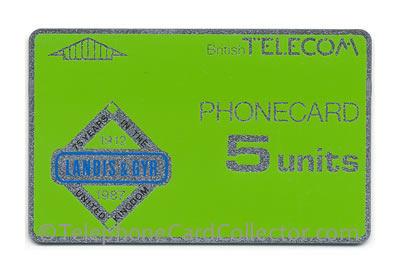
Pictured above - Landis & Gyr 75 years in the United Kingdom - 1912 to 1987 - commemorative BT Phonecard.
Cardphone Trial Locations and Research
Market research carried out in September 1978 showed that traveling businessmen would provide the majority of Cardphone customers. As the number of Cardphones available for the trial was limited to just 200 it was decided to attempt to create a national system in miniature i.e. to ensure that a certain sector of the public would have the opportunity to use a Cardphone where they happened to be. So with this in mind, the trial was confined to 4 regions along the London to North West travel axis, with the majority of cardphones sited in London.
Cardphones were sited in eight London areas - City, Centre, North-Central, North-West, West, South-West, South, South-Central - and in Birmingham, Manchester (Central and South) and Glasgow.
Following the results of the market research, Cardphones were sited, for the most part, at British Rail mainline stations and air shuttle airports, and also at major London Underground stations. A few were placed in street sites but near coin telephones since the Cardphone as it was important to allow customers a choice of payphone. In nearly all cases, Cardphone replaced a Pay-On-Answer telephone.
Cardphone trial begins
The cardphone trial was officially launched in London by BT Chairman Sir George Jefferson on 28th July 1981.
Did you know? Sir George Jefferson, along with many other BT managers, had his own visiting Phonecard created. The 100 unit card (pictured right) was issued in 1987 and features a colour photo of the Kapellbrücke (Chapel Bridge) in Luzern (Lucerne) Switzerland.
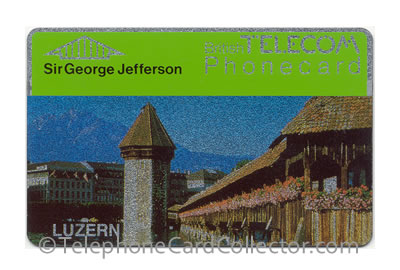
Pictured above - Sir George Jefferson 100unit first full colour internal BT Phonecard issued in August 1987.
The cardphone trial lasted from July 1981 to April 1982.
The trial had three objectives: to access
‣the financial performance of the cardphone,
‣its reliability in the field, and
‣its acceptability to the customer.
This history of the BT Phonecard will continue... Can you help with the content for this page? If so, please see my contact page.
Source: British Telecom - The Cardphone Trail Report - ICS 1.3 - November 1982.
Cardphones hailed a success
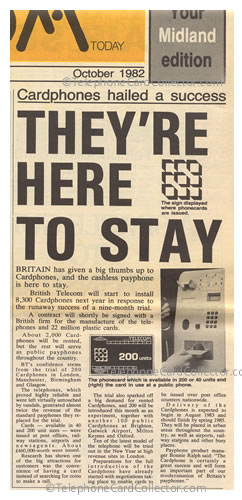 The following is taken from the October 1982 British Telecom staff newspaper - 'Telecom Today' (pictured left) on the success of the Cardphone trial.
The following is taken from the October 1982 British Telecom staff newspaper - 'Telecom Today' (pictured left) on the success of the Cardphone trial.
Britain has given a big thumbs up to Cardphones, and the cashless payphone is here to stay.
British Telecom will start to install 8,300 Cardphones next year in response to the runaway success of a nine-month trial.
A contract will shortly be signed with a British firm for the manufacture of the telephones and 22 million plastic cards.
About 2,000 Cardphones will be rented, but the rest will serve as public payphones throughout the country.
BT's confidence stems from the trial of 200 Cardphones in London, Manchester, Birmingham and Glasgow.
The telephones, which proved highly reliable and were left virtually untouched by vandals, generated almost twice the revenue of the standard payphones they replaced for the trial.
Cards - available in 40 and 200 units sizes - were issued to post offices, railway stations, airports and newsagents. About £460,000-worth were issued.
Pictured right - They're here to stay - the front page article from the October 1982 issue of 'Telecom Today'. Click the image for a larger view.
Research has shown one of the big attractions for customers was the convenience of having a card instead of searching for coins to make a call.
The trial also sparked off a big demand for rented Cardphones, and 200 will be introduced this month as an experiment, together with another 100 public Cardphones at Brighton, Gatwick Airport, Milton Keynes and Oxford.
Ten of the latest model of the telephone will be tried out in the New Year at high revenue sites in London.
Preparations for the full introduction of the Cardphone have already started with negotiations taking place to enable cards to be issued over post office counters nationwide.
Delivery of the Cardphones is expected to begin in August 1983 and should finish by spring 1985. They will be placed in urban areas throughout the country, as well as airports, railway stations and other busy places.
Payphone product manager Bonnie Ralph said: "The Cardphone is certainly a great success and will form an important part of our modernisation of Britain's payphones."
Phonecard expansion and modernisation
Throughout the nineteen-eighties the number of Phonecard payphones increased significantly across the country.
One such place that was chosen for a high number of cardphone payphones was Swindon in Wiltshire. It was recognised by British Telecom that Phonecard payphones were five times less susceptible to vandalism than their coin-operated counterparts.
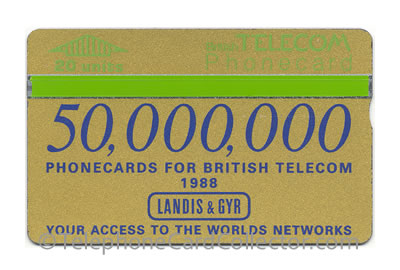
Pictured above - Celebrating 50,000,000 Phonecards for British Telecom supplied by Landis & Gyr in 1988.
In May 1988 British Telecom embarked on a expansion programme that saw the total number public payphones in Swindon rise from 138 to 175. Incredibly Phonecard payphones made up a 65% of the total 175 locations across the town. Read more about Swindon's expansion programme.
In 1993 a Winning Matters BT Phonecard (pictured below) was issued internally to British Telecom staff with two clear messages. The first was to encourage BT staff to promote sales and to keep an eye on competitor activity by telephoning a freephone 0800 number. While the second was to promote the use of BT Phonecards. Accompanied with the telephone card was a leaflet which read at the base:
PS. Using a BT Phonecard is simple. Just push it into the slot and dial, using any of 22,000 public Cardphones in the UK. Every family member should carry one - to ring home when buses or trains run late, or when plans change. They're ideal to give youngsters, since, unlike coins, they cannot be spent on pocket money treats!
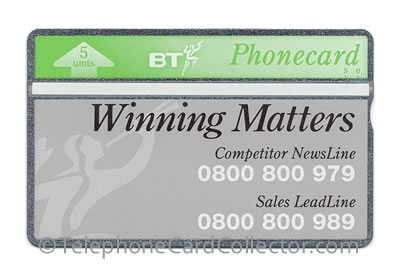
Pictured above - Internal BT Phonecard given to BT staff to help promote BT Phonecards and the use of.
Technology Change
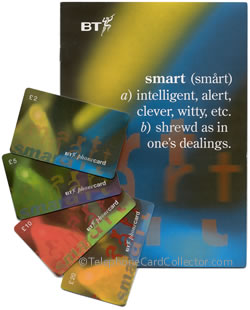 By the mid nineties British Telecom (BT) Phonecards which since launch in 1981, had been based on optical technology and were produced by Landis and Gyr, this was about to change with the introduction of a new chip BT Phonecard which used embedded microchip technology.
By the mid nineties British Telecom (BT) Phonecards which since launch in 1981, had been based on optical technology and were produced by Landis and Gyr, this was about to change with the introduction of a new chip BT Phonecard which used embedded microchip technology.
Beginning in 1994 British Telecom commenced trials to test the funtionality of payphones manufactured by Landis and Gyr, GPT and Schlumberger using phonecards of various denominations supplied by GPT and Gemplus. Initial tests were carried out by BT laboratories at Martlesham before further closed user trials were carried out, such as the Beta Trial in The Solent in 1995.
Pictured right - BT Smartcard Presentation pack featuring four of the trial smart cards. These packs were given away by British Telecom to Phonecard stockists/retailers in the Solent trial area.
Read more about Chip Cards that were introduced by BT in 1996.
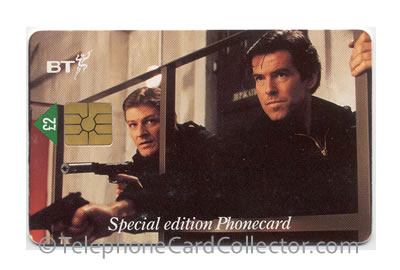
Pictured above - part of a six card set, a chip BT Phonecard features a scene from the James Bond film Goldeneye.
Last updated: 2nd January 2026
Popular Pages
Collector Shop
Site Maps
TelephoneCardCollector.com © 2013-2026
Please do NOT copy any content without prior consent, thank you.

